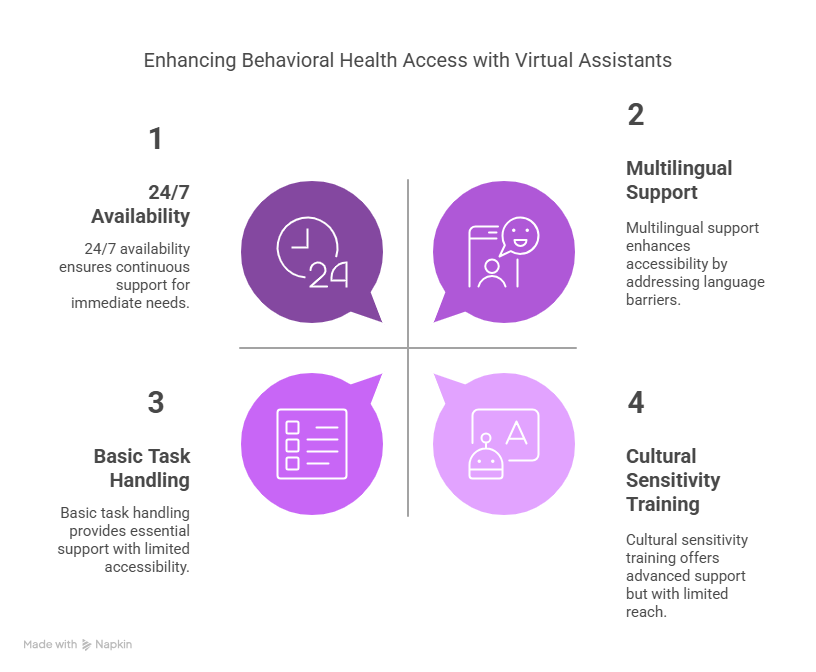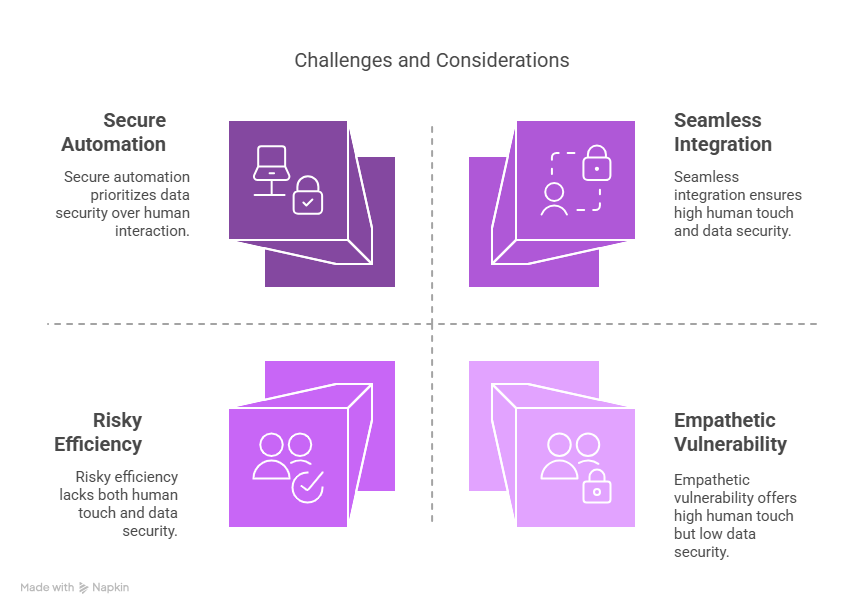How VAs Can Enhance Behavioral Health Customer Service
08 May 2025 By: Mary Dellosa
Updated

Behavioral health is changing fast. Great customer service now matters more than ever. Virtual Assistants help boost care by making support quicker and easier. This article shows how virtual assistants improve behavioral health customer service by raising efficiency, access, and client happiness.
The Role of Virtual Assistants in Behavioral Health Customer Service
Virtual Assistants use smart technology to handle tasks like booking visits and sharing service info. In behavioral health, they help smooth out work and give fast support to clients.
Streamlining Administrative Tasks
VAs save time by handling admin work like booking visits, updating records, and filing insurance claims. This lets staff focus more on care, not paperwork. VAs can also sync with EHRs, reducing manual entry and preventing errors. They gather pre-visit forms and screen clients, freeing up clinicians’ time.
They also send reminders and follow-ups, which cut down missed visits and keep clients involved. VAs track patterns and preferences too, helping clinics adjust schedules and services. This smart use of data boosts both efficiency and patient satisfaction.
Enhancing Communication
Good communication matters most in behavioral health. Clients need quick, kind replies. VAs help by answering questions and sharing treatment info fast.
They can speak with care, which builds trust. VAs also share tools like coping tips or mindfulness guides, helping clients stay involved in their care. This support builds stronger bonds and leads to better outcomes. VAs follow empathetic scripts, creating warm, caring replies. They also work across chat, text, or email to meet clients on their preferred platform. VAs keep communication smooth, steady, and always available.
Improving Accessibility to Services
Access to care can be tough for many in behavioral health. VAs help by offering support anytime, even after hours. This lets clients get help when they need it most.

24/7 Availability
VAs work 24/7, giving clients support anytime. This helps those in crisis or too shy to call during the day. Fast replies matter when time is critical. VAs also sort urgent needs, sending clients to the right help. If someone feels anxious or depressed, a VA can link them to a therapist or hotline fast.
This also eases staff workload. VAs handle simple tasks so teams can focus on tougher cases. That speeds up service and keeps clients happy. VAs can also help manage waitlists by offering earlier slots from cancellations. They connect clients to nearby support by using geo-targeting, often boosted by residential mobile proxies to pinpoint and direct clients based on where they are in real time.
Language and Cultural Support
Language barriers often block access to care. VAs with multilingual skills help by speaking the client’s language, making care clear and respectful.
They support diverse needs by understanding culture and offering tailored help. This builds trust and keeps clients engaged in their treatment. VAs can also suggest culturally relevant books, events, or support groups. This promotes mental health in a way that fits the client’s background. Some VAs receive cultural training, helping them respond with care to diverse beliefs, values, and needs.
Personalizing the Client Experience
Personalized care matters in behavioral health. VAs use data to shape support for each client’s needs. With smart tools and machine learning, VAs spot trends and habits. This helps them give care that feels more personal and effective. VAs also analyze chat tone and past chats to adjust replies or suggest the next best step based on mood and behavior.
Customized Communication
VAs use client data to send custom messages and reminders. These can match goals, therapy dates, or stress tips based on each person’s needs. They might also share articles or videos that fit a client’s struggles or interests. This makes care feel personal and thoughtful.
When clients see that care is tailored to them, they feel valued. It builds trust and keeps them more involved in their treatment.
Feedback and Continuous Improvement
Client feedback helps improve care. VAs can ask questions or send surveys after visits to gather honest input from clients. This feedback shows what works and what needs fixing like booking issues or lack of resources. It gives clear paths for better service. They also flag negative feedback fast, so teams can step in and fix problems early. Patterns in feedback help improve overall service.
When clients see their input sparks change, they feel heard. This builds trust and keeps them engaged in their care and loyal to the service.
Challenges and Considerations
VAs offer big benefits, but also bring risks. Careful planning is key to make sure they help, not hurt, the quality of care.

Maintaining Human Touch
One key concern is losing the human touch. Clients need real empathy, not just fast replies. VAs handle simple tasks so staff can focus on deep, caring talks. With training, teams can blend VAs into care smoothly, keeping service warm and human. Ongoing training keeps VAs aligned with best practices. Supervisors should monitor chats to ensure clients always get kind, helpful replies.
Data Privacy and Security
Protecting client data is critical. VAs must follow HIPAA rules to keep trust strong and info safe. Firms need strong security, clear rules on data use, and regular checks. Clients should know how their data is used and protected.
This openness builds trust and helps clients feel safe using the tech. It also keeps care compliant and up to date.
Implementing VAs in Behavioral Health Settings
To get the most from VAs, organizations need a smart plan. Good setup boosts the benefits and lowers the risks.
Assessing Needs and Goals
Start by finding what your team needs most. Look at what’s not working well in service and where VAs could help. Talk to staff and clients. Their views help shape a plan that fits your goals and mission.
Measuring Success and Impact
After setup, track how VAs perform. Use KPIs to see if they meet client needs and improve service.
Client Satisfaction Surveys
Run regular surveys to check how VAs are doing. Ask about speed, access, and overall service. Use the feedback to spot gaps and keep improving. This ensures VAs stay useful and client needs stay met.
Operational Efficiency Metrics
Track how VAs affect workflow like how fast they book visits, reply to questions, and cut admin work. This data helps teams tweak service and use VAs better over time.
Trending Now
Many psychologists are leaving insurance networks due to low pay, heavy admin tasks, and payment issues. These problems make mental health care harder to access. Insurers often demand patient notes, delay payments, or audit services years later, clawing back large sums. Some even pressure therapists to shorten treatment for severe cases. This creates stress for providers and limits care for those in need
A report by the National Council for Mental Wellbeing found that 93% of behavioral health workers have experienced burnout, with 62% reporting moderate to severe levels. Poor scheduling practices can lead to errors, high turnover, and reduced quality of care.
Conclusion
VAs can transform behavioral health service. They cut admin work, boost access, and tailor support, raising client satisfaction and care results.
Ready to elevate your behavioral health customer service with the power of Virtual Assistants? Look no further than HelpSquad Health. Our skilled healthcare virtual assistants are available 24/7 to streamline your administrative tasks, enhance client communication, and personalize your customer interactions, all starting at an affordable $8.50 per hour. Don’t miss the opportunity to transform your client experience and improve your operational efficiency. Start your trial with HelpSquad today and witness the difference we can make!


